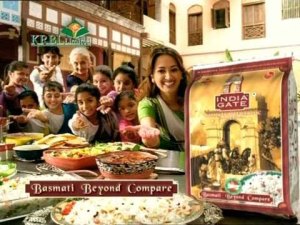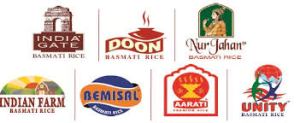KRBL, is India’s leading exporter of branded basmati rice and owner of the largest rice milling capacities, has consistently outperformed peers in past few years. A strong brand and an efficient wcap mgmt have enabled KRBL to tap growth in Basmati rice industry.
Domestically also, the demand for basmati rice has been growing at healthy rates ,12-15% CAGR for past ten years and the trend is expected to continue with increasing disposable income .
BUSINESS
Both the basmati and non-basmati sectors present the organised players with tremendous opportunities since organised players have a low presence in both the segments. The former is a high margin export oriented segment while the latter provides the alternative of value-added products derived while processing. The fragmented players lack the technology and expertise in procurement process required for these high end activities. Hence, the large players have the scope to take up the advantage and capture the market.
There are more than 139,000 rice processing mills in India processing about 132 mn tonnes of paddy. Out of this, a little over 25% (35,000) are classified as modernised rice mills.
Effective procurement: Quality is the most important characteristic for maintaining brand recognition in the market. This requires effective procurement process for paddy. Large players can procure the bulk volume through upfront payments to farmers and middlemen
-product/ service Usage (essential or lifestyle)
Lifestyle product , better taste , prices vary widely depending on brands , starting form Rs 80-90/kg
-Product/Service type (brand or commodity )
The market for basmati rice is moving towards a more organised one with consumer preference increasing towards branded choices
–In last two years in India , production of paddy(basmati variety) has not shown growth pushing up prices by north of 20% and yet the demand has been solid.
Understanding the supply
-Export of Basmati in 2013 4.02 Mn tonnes ( volume )
4.5 Bn USD ( value)
– Company has 30% share in the organized domestic market and 25% share in the branded basmati rice exports market
Raw Material
Paddy is the main raw material for the company and is the main component of costs for the company(`80% of sales)
The prices of paddy vary season to season based on production which is a function of weather, area under cultivation , plantation techniques, hybrid varieties etc
Industry Structure and competitors
Basmati exports industry has 5-6 big players enjoying majority of the sales. And, major competitors are KRBL, REI agro, Kohinoor, LT overseas
COMPETITIVE ANALYSIS/moating points
The company enjoys a huge scale advantage in terms of procurement, distribution, advertising and R&D.
KRBL ties up directly with the farmers for procurement of paddy, providing them technical expertise leading to better yields , reduction in risk by providing good value without involving intermediaries .
Contract farming forms 80% of the raw material purchase of the company. And ensures timely availability and quality of grains for the company .
The company has 2,40,000 acres under contract farming.
Pan-India distribution network with presence at 6,40,000 retail outlets across 28 states
KRBL has highest milling capacity of 195 MT/hr which is significantly ahead of nearest peer REI agro (118 MT/hr).
Financials
Company took a positive step in converting long-term debt into WC loans since this amount is mostly utilized for stocking of grains(Basmati rice needs to be stored for a year atleast) and also the company is slowly deleveraging itself with D/E ratio going down from 1.4 in 2011 to 1.0 in 2014
-Tax rate already@30 % to remain stable
– Ratio of export sales to domestic is 1:1. Domestic market has shown higher growth in recent past
– Margin triggers going forward(sales mix, op . leverage ,economies of scale,cost efficiencies ). The company is expecting to raise capacity utilization levels at Dhuri plant from 40% to 65%
-Capital efficiency triggers going forward (reducing WC requirements etc). the company has shown huge improvement in working capital days from 389 in 2008 to 277 in 2013.
One big positive with KRBL, which also shows company’s brand strength is advances it receives from customers. (2013 figure : 176 cr)
– Company doesn’t require any major capex going forward 2-3 years as it already has enough capacity on board.
PEOPLE
-Buyback
The company took a wise decision of buying back its own shares owing to depressed prices of company’ stock and in twelve months leading to Feb 2014 , bought back 77,22,048 equity sharesat an average price of Rs 23.58 per share
-Promoter holding stands at 58.65% after buyback
– Promoter compensation(as a % of net Profits ) is 7.5%, which is on the higher side .
PRICE
As on 09 May 2014 , the company’s market cap is 1464 crs with Last year FY2013-14 profits of 255.11 crs ,quoting at a p/e of 5.7
If the company is able to increase profits moderately at 20-25% CAGR over next 3-4 years and with the help of a slight p/e expansion, we can have a good upside in this stock
RISKS
– Geo-political Risk
The middle east is the biggest importer for Indian Basmati rice and accounts for almost 35% of KRBL revenues. KRBL mostly exports to Saudi Arabia ,UAE, Iraq Kuwait . Any political turmoil in this region may adversely impact exports,
We had already seen in 2011-12 ,UN imposed sanction on Iran and it adversely affected company sales and profits showed a negative growth of ~30%.Since then, company is consciously trying to reduce exposure to Iran.
– Movement in foreign currency
– Fluctuations in raw material prices
– Regulatory changes
Why?
Q. They say they command a significant price premium over other brands, but why is it not leading to superior return on capital ?
The coming times should be better for the company as now many things seem to be falling in place.
-better financial structure
-branding
-better capacity utilization
-sales growth
-efficient mgmt. of Wcap
It should show improvement in ROIC in coming times.
Q. do they have inventory risk, since rice needs to be stored for a year atleast to distill its quality ? does food inflation over a longer term mitigate this risk ?
Q. which are leading consumption geographies,demand drivers ,demand growth patterns ?
– domestic demand
– export demand mainly from middle east
-EU(mainly UK), China are opening up as new markets for Basmati exporters
Q. The company had negative growth in profits and margin contraction in 2011-12. Why ?
2011-12 was a bad year for the company and basmati export industry as a whole.
UN imposed sanctions on Iran, Dollar payments couldn’t be made and later a rupee payment mechanism was established.
Q. Company follows the strategy of serving all price segments from rs 30/kg to rs 150/kg. Why all segments ?
Since penetration of organized sector is low in non –basmati segments and also seeing it as a scalable, company is serving lower-priced segments also. Although, non-basmati rice are a very small proportion of total sales of the company.
Q. Is it a structurally bad business by nature, since it has huge WC requirements (Basmati needs to be stored for a year).
Company has shown in recent past that better financial management and efficient capacity utilization can bring improvement in ROIC.
Q. Should it get auditing done by a more reputed firm, present auditors; Vinod Kumar bindal & co.


